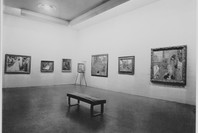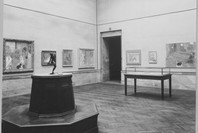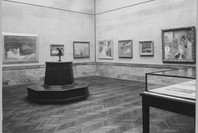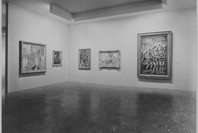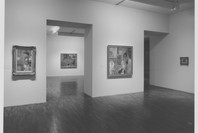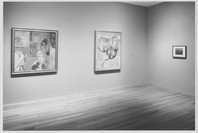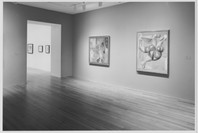The scene is the bathroom of Bonnard’s own home and the woman naked at her toilette is the artist’s wife, Marthe, accompanied in the foreground by their dog, Pouce. Although Marthe appears in many of Bonnard’s paintings, seldom is her face fully visible, creating a sense of casual intimacy. Bonnard painted his unstretched canvases from memory, assisted only by small sketches. His technique and his use of color—applied in seemingly spontaneous, discrete strokes—are indebted to Impressionism, but the flatness of the image and the high-pitched hues of color in this work were in deep accord with the latest modernist practices.
Gallery label from 2011.
The scene is the bathroom of Bonnard's own home—Le Bosquet, his house near Cannes—and the woman naked at her toilette is the artist's wife, Marthe. The choice of both space and figure, then, is intensely personal, and the work maintains a sense of privacy and even of confinement. Although Marthe appears in many of Bonnard's paintings, seldom is her face fully visible: here she bows her head low. The window is shuttered, sealing off the outside world. A painting in which the whites of bath and stool are brighter and more vibrant than the barred panel of daylight suggests claustrophobia as well as intimacy, even though Bonnard's extraordinary painted color implies the richness of the domestic and interior life.
Bonnard's composition is asymmetrical, darker on the right than on the left, and its human subject is off-center and out of focus. His technique and use of color emerge from Impressionism, but advance the independence of paint quality and surface from form. Indeed the work's intensity as a field of color may outweigh its descriptiveness: overlapping planes, indistinct patterns, balanced areas of coolness and warmth, and close-valued hues create a blurring of edges and textures, a shimmer. Behind the curving foreground forms, systematic grids of rectangles and lozenges create a structure of eminent logic.
Publication excerpt from The Museum of Modern Art, MoMA Highlights, New York: The Museum of Modern Art, revised 2004, originally published 1999, p. 160.

